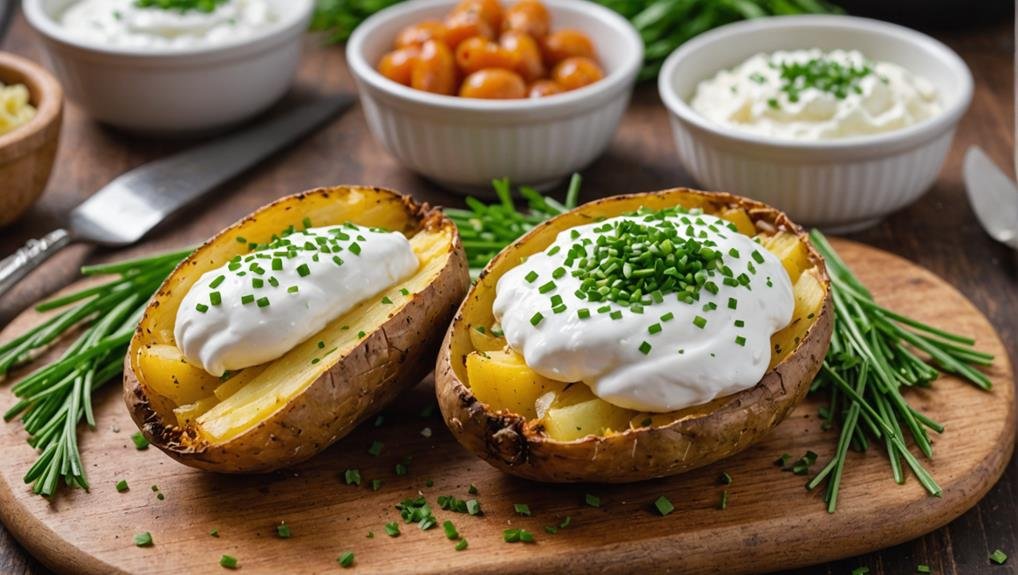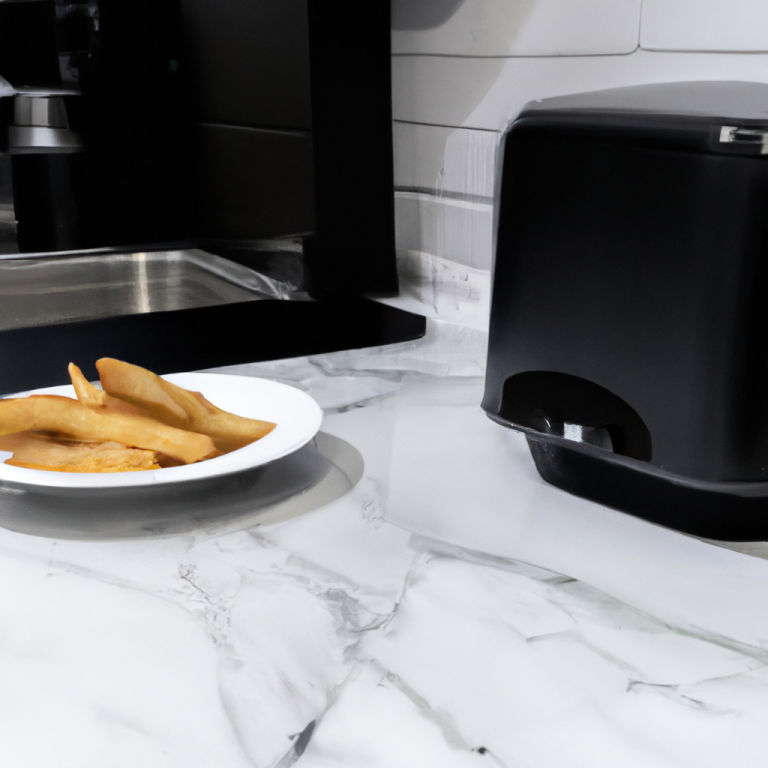To make a baked potato in an air fryer, start by selecting medium to large Russet or Yukon Gold potatoes for the best texture. Wash the potato under cold water, poke holes with a fork, and dry it thoroughly. For added flavor, rub the skin with olive oil and sprinkle with salt. Preheat the air fryer to 400°F (204°C), then cook the potatoes for 35 to 45 minutes, depending on their size, turning them halfway through. For an extra crispy skin, brush with oil after cooking and return them to the fryer briefly. Further insights on toppings and serving can enhance your culinary experience.
Choosing the Right Potato
When selecting a potato for baking in an air fryer, opt for varieties that are best suited for achieving a fluffy interior and crispy skin. The most recommended types for this purpose are Russet potatoes, known for their high starch content, which contributes to a light and airy texture. Their thick skin allows for maximum crispiness when cooked at high temperatures, making them a preferred choice for many culinary enthusiasts.
Another viable option is the Yukon Gold potato, which possesses a slightly waxy texture. This variety offers a creamy interior that can also yield delicious results in the air fryer. While they may not achieve the same level of fluffiness as Russets, they can provide a rich flavor profile that many find appealing.
It is essential to select medium to large-sized potatoes for even cooking. Smaller potatoes may cook too quickly, resulting in an underwhelming texture.
Additionally, confirm that the potatoes are free from blemishes or soft spots, as these imperfections can adversely affect the final product. By carefully choosing the right potato, one can set the stage for a delightful baked potato experience in the air fryer.
Preparing the Potato
After selecting the right potato, the next step is to prepare it for the air fryer. Proper preparation is essential to achieve that perfectly baked texture and flavor. This process involves a few key steps that guarantee your potato cooks evenly and has a delightful crispiness on the outside.
- Wash the Potato: Rinse the potato under cold water to remove any dirt or debris. A clean surface will help in achieving a better texture.
- Poke Holes: Use a fork to poke several holes in the potato. This allows steam to escape during cooking, preventing the potato from bursting.
- Dry Thoroughly: Pat the potato dry with a paper towel to eliminate excess moisture. A dry potato skin will contribute to a crispier exterior.
- Primal Kindness: If desired, rub a small amount of oil over the skin. This step enhances browning and adds flavor, though it is optional.
Following these preparation steps will set the foundation for a delicious baked potato, ready to be transformed into a culinary delight in your air fryer.
With a bit of attention, your potato will be primed for cooking perfection.
Seasoning Options
There are numerous seasoning options available to elevate the flavor of your baked potato. The most straightforward approach involves using a combination of salt and pepper, which enhances the natural flavors while providing a savory foundation.
Olive oil or melted butter can be brushed onto the potato skin before seasoning, resulting in a crispy exterior that is both delicious and visually appealing.
For those seeking a more adventurous palate, consider adding garlic powder, onion powder, or smoked paprika. These spices introduce layers of flavor that complement the potato’s inherent earthiness.
Alternatively, fresh herbs such as rosemary, thyme, or chives can be finely chopped and sprinkled over the potato, offering a revitalizing contrast.
If you prefer a richer taste, cheese is an excellent option; shredded cheddar or crumbled feta can be added before serving.
Additionally, sour cream or Greek yogurt can serve as a tangy topping, further enhancing the experience.
For a unique twist, experiment with toppings like bacon bits, jalapeños, or even a drizzle of barbecue sauce.
Ultimately, the seasoning you choose can transform a simple baked potato into a personalized culinary delight, allowing for creativity and expression in your cooking.
Preheating the Air Fryer
Achieving the perfect baked potato in an air fryer begins with proper preparation, which includes preheating the appliance. Preheating is vital as it guarantees that the air fryer reaches the ideal cooking temperature before placing the potatoes inside. This step enhances the cooking process, allowing for a crispy skin and fluffy interior.
Here are four important reasons to preheat your air fryer:
- Consistent Cooking: Preheating guarantees that the heat is evenly distributed throughout the air fryer, leading to uniform cooking and preventing unevenly baked areas.
- Crispier Texture: A preheated air fryer helps achieve that desirable crispy texture on the skin of the potato, enhancing the overall eating experience.
- Reduced Cooking Time: By starting with a hot appliance, you can greatly reduce the overall cooking time, allowing you to enjoy your baked potato sooner.
- Improved Flavor: Preheating can enhance the flavors of the potatoes, as they begin to cook immediately upon entering the hot air fryer, locking in moisture and taste.
Cooking Time and Temperature
Determining the ideal cooking time and temperature is vital for achieving the perfect baked potato in an air fryer. Generally, a temperature of 400°F (204°C) is recommended, as it allows for even cooking and a crispy skin, which is a hallmark of a well-baked potato.
Depending on the size of the potato, the cooking time will typically range from 35 to 45 minutes. For smaller potatoes, around 5 to 7 ounces, you may find that 35 minutes is sufficient, while larger potatoes, weighing 8 ounces or more, may require the full 45 minutes to reach peak tenderness.
It is important to keep in mind that variations in air fryer models can affect these times. Some air fryers may cook more quickly or slowly, necessitating adjustments.
Additionally, a good practice is to turn the potatoes halfway through the cooking process to guarantee uniform cooking and browning. By adhering to these guidelines, you can consistently achieve that perfect balance of a fluffy interior and a crispy exterior, elevating your baked potato experience to a delightful culinary endeavor.
Checking for Doneness
To guarantee your baked potato is perfectly cooked, checking for doneness is an essential step in the process. An undercooked potato can be unappetizing, while an overcooked one may lose its desired texture. As a result, employing reliable methods to confirm doneness is vital.
Here are four effective techniques to check if your baked potato is ready:
- Fork Test: Gently insert a fork into the potato. If it slides in easily, the potato is tender and done. If resistance is felt, it may need additional cooking time.
- Internal Temperature: Use a food thermometer to check the internal temperature. A fully cooked potato should reach at least 205°F (96°C).
- Visual Inspection: Look for a slightly wrinkled skin and a soft appearance. The skin should not appear shiny, which indicates moisture that can lead to an undercooked potato.
- Time Check: Refer to your cooking time. Typically, a medium-sized potato takes about 35-40 minutes in an air fryer at 400°F (200°C). Adjust based on the size of the potato.
Crisping the Skin
Once you have confirmed that your baked potato is fully cooked, the next step is to enhance its appeal by crisping the skin. Achieving a crispy exterior is essential, as it adds texture and visual appeal to the dish.
To start, carefully remove the potato from the air fryer and let it rest for a few minutes. This resting period allows the steam to escape, preventing the skin from becoming soggy.
Next, brush the skin lightly with olive oil or melted butter, ensuring an even coating. This fat not only promotes browning but also enhances flavor. For an extra kick, consider sprinkling the skin with salt, garlic powder, or your preferred seasoning blend. These additions not only elevate the taste but also contribute to the crispiness.
Once seasoned, return the potato to the air fryer and increase the temperature to 400°F (200°C). Cook for an additional 5 to 10 minutes, monitoring closely to prevent over-browning.
The result will be a beautifully crisp skin that contrasts delightfully with the fluffy interior, making your baked potato irresistible. Enjoy the satisfying crunch that complements the creamy goodness within.
Serving Suggestions
Elevating the experience of a baked potato begins with thoughtful serving suggestions that complement its rich flavor and texture.
The presentation of your baked potato can greatly enhance its appeal and satisfaction, transforming a simple dish into a delightful culinary experience.
Consider the following suggestions that not only elevate the dish but also encourage creativity in your meal planning.
- Accompaniments: Serve your baked potato alongside an invigorating salad or grilled vegetables; this adds a vibrant contrast and boosts nutritional value.
- Protein Pairings: Complement your baked potato with a protein source, such as grilled chicken or a savory steak, which can create a hearty meal.
- Dips and Sauces: Offer an array of dips, such as sour cream or a zesty vinaigrette, that can enhance the flavors and provide an interactive dining experience.
- Beverage Selection: Consider pairing your meal with a refreshing beverage, such as iced tea or a light sparkling water, to cleanse the palate between bites.
Toppings and Garnishes
A variety of toppings and garnishes can transform a simple baked potato into a gourmet delight, enhancing both its flavor and visual appeal. The classic choice is a dollop of sour cream, which adds a creamy texture and tangy taste, but there are countless alternatives to explore.
Chives or green onions provide a fresh, mild flavor that beautifully complements the potato’s earthiness. For a heartier option, consider adding crispy bacon bits, which introduce a savory crunch that elevates the overall experience.
Cheese lovers can rejoice with an assortment of melted cheeses, such as cheddar, mozzarella, or even goat cheese, offering a rich and satisfying flavor profile. For a healthier twist, Greek yogurt can be used as a substitute for sour cream, while also adding a protein boost.
Vegetables, such as steamed broccoli or sautéed mushrooms, can enhance the nutritional value while adding vibrant colors and textures.
Storing Leftover Potatoes
After enjoying a gourmet baked potato adorned with your favorite toppings, you may find yourself with leftovers. Proper storage of these delicious remnants is crucial to maintain their flavor and texture for future enjoyment. Here are some effective methods to guarantee your leftover baked potatoes remain delightful:
- Cool Before Storing: Allow the potatoes to come to room temperature before placing them in the refrigerator, as this helps prevent condensation, which can lead to sogginess.
- Wrap Tightly: Use aluminum foil or plastic wrap to securely wrap each potato. This protects them from absorbing odors and keeps them moist.
- Use Airtight Containers: For added protection, consider placing the wrapped potatoes in an airtight container. This further preserves their quality and prevents freezer burn if you opt to freeze.
- Label and Date: If you choose to freeze your potatoes, label them with the date of storage. This practice helps you keep track of how long they have been stored, guaranteeing peak freshness when you decide to enjoy them again.
Bottom Line
To conclude, preparing a baked potato in an air fryer is a straightforward process that yields delicious results. By selecting the appropriate potato variety, properly preparing and seasoning it, and adhering to recommended cooking times, ideal texture and flavor can be achieved. Additionally, the versatility in toppings and garnishes allows for customization to suit individual preferences. Ultimately, utilizing an air fryer not only enhances the cooking experience but also contributes to a quicker and more efficient meal preparation method.



